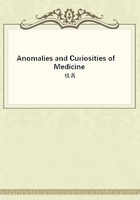
第21章
The curious cases mentioned by older writers, and called abortion by the mouth, etc., are doubtless, in many instances, remnants of extrauterine pregnancies or dermoid cysts. Maroldus speaks in full of such cases; Bartholinus, Salmuth, and a Reyes speak of women vomiting remnants of fetuses. In Germany, in the seventeenth century, there lived a woman who on three different occasions is said to have vomited a fetus. The last miscarriage in this manner was of eight months' growth and was accompanied by its placenta. The older observers thought this woman must have had two orifices to her womb, one of which had some connection with the stomach, as they had records of the dissection of a female in whom was found a conformation similar to this.
Discharge of the fetal bones or even the whole of an extrauterine fetus by the rectum is not uncommon. There are two early cases mentioned in which the bones of a fetus were discharged at stool, causing intense pain. Armstrong describes an anomalous case of pregnancy in a syphilitic patient who discharged fetal bones by the rectum. Bubendorf reports the spontaneous elimination of a fetal skeleton by the rectum after five years of retention, with recovery of the patient. Butcher speaks of delivery through the rectum at the fourth month, with recovery. Depaul mentions a similar expulsion after a pregnancy of about two months and a half. Jackson reports the dissection of an extrauterine sac which communicated freely with the large intestine. Peck has an example of spontaneous delivery of an extrauterine fetus by the rectum, with recovery of the mother. Skippon, in the early part of the last century, reports the discharge of the bones of a fetus through an "imposthume" in the groin. Other cases of anal discharge of the product of extrauterine conception are recorded by Winthrop, Woodbury, Tuttle, Atkinson, Browne, Weinlechner, Gibson, Littre, Magruder, Gilland, and many others. De Brun du Bois-Noir speaks of the expulsion of extrauterine remains by the anus after seven years, and Heyerdahl after thirteen years.
Benham mentions the discharge of a fetus by the rectum; there was a stricture of the rectum associated with syphilitic patches, necessitating the performance of colotomy.
Bartholinus and Rosseus speak of fetal bones being discharged from the urinary passages. Ebersbach, in the Ephemerides of 1717, describes a necropsy in which a human fetus was found contained in the bladder. In 1878 White reported an instance of the discharge of fetal remains through the bladder.
Discharge of the Fetus through the Abdominal Walls.--Margaret Parry of Berkshire in 1668 voided the bones of a fetus through the flesh above the os pubis, and in 1684 she was alive and well, having had healthy children afterward. Brodie reports the history of a case in a negress who voided a fetus from an abscess at the navel about the seventeenth month of conception. Modern instances of the discharge of the extrauterine fetus from the walls of the abdomen are frequently reported. Algora speaks of an abdominal pregnancy in which there was spontaneous perforation of the anterior abdominal parietes, followed by death. Bouzal cites an extraordinary case of ectopic gestation in which there was natural expulsion of the fetus through abdominal walls, with subsequent intestinal strangulation. An artificial anus was established and the mother recovered. Brodie, Dunglison, Erich, Rodbard, Fox, and Wilson are among others reporting the expulsion of remnants of ectopic pregnancies through the abdominal parietes. Campbell quotes the case of a Polish woman, aged thirty-five, the mother of nine children, most of whom were stillborn, who conceived for the tenth time, the gestation being normal up to the lying-in period. She had pains followed by extraordinary effusion and some blood into the vagina. After various protracted complaints the abdominal tumor became painful and inflamed in the umbilical region. A breach in the walls soon formed, giving exit to purulent matter and all the bones of a fetus. During this process the patient received no medical treatment, and frequently no assistance in dressing the opening.
She recovered, but had an artificial anus all her life. Sarah McKinna was married at sixteen and menstruated for the first time a month thereafter. Ten months after marriage she showed signs of pregnancy and was delivered at full term of a living child; the second child was born ten months after the first, and the second month after the second birth she again showed signs of pregnancy.
At the close of nine months these symptoms, with the exception of the suppression of menses, subsided, and in this state she continued for six years. During the first four years she felt discomfort in the region of the umbilicus. About the seventh year she suffered tumefaction of the abdomen and thought she had conceived again. The abscess burst and an elbow of the fetus protruded from the wound. A butcher enlarged the wound and, fixing his finger under the jaw of the fetus, extracted the head.
On looking into the abdomen he perceived a black object, whereupon he introduced his hand and extracted piecemeal an entire fetal skeleton and some decomposed animal-matter. The abdomen was bound up, and in six weeks the woman was enabled to superintend her domestic affairs; excepting a ventral hernia she had no bad after-results. Kimura, quoted by Whitney, speaks of a case of extrauterine pregnancy in a Japanese woman of forty-one similar to the foregoing, in which an arm protruded through the abdominal wall above the umbilicus and the remains of a fetus were removed through the aperture. The accompanying illustration shows the appearance of the arm in situ before extraction of the fetus and the location of the wound.